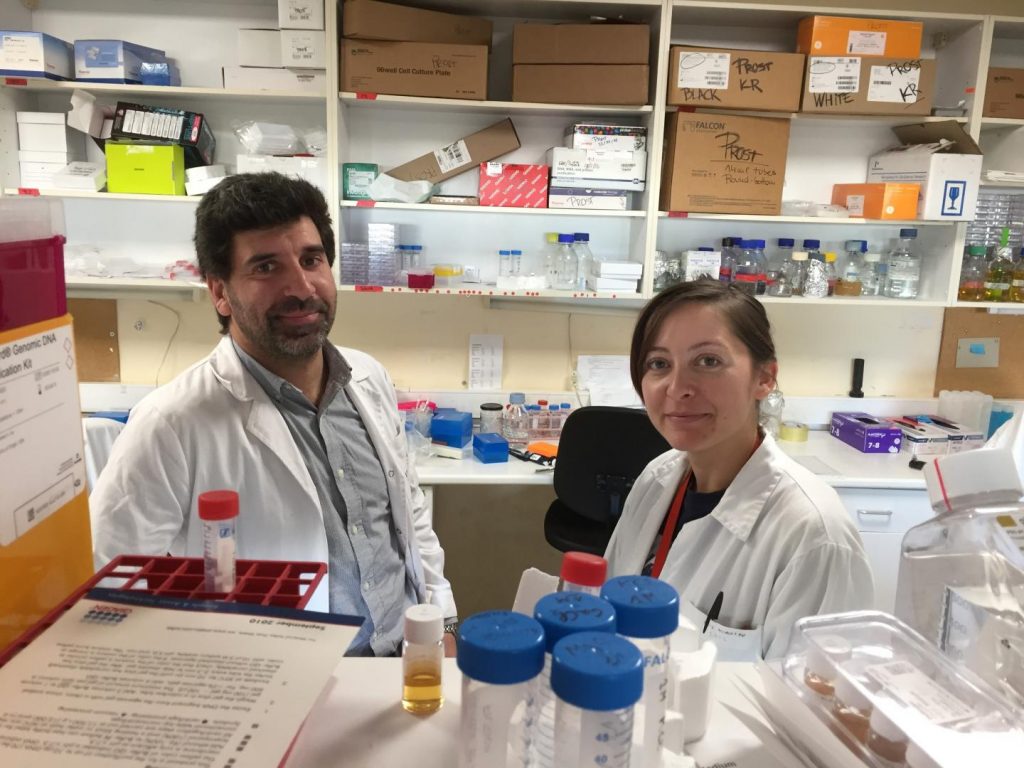Scientists in the U.S., Spain, and Switzerland have identified a protein that could represent a new target for treatment-resistant and metastatic prostate cancer. Studies in genetically engineered mouse models (GEMM) and data from human prostate cancer patients indicate that administering drugs targeting the histone methyltransferase nuclear receptor binding SET domain protein 2 (NSD2) in combination with conventional prostate cancer treatments could boost effectiveness against advanced and metastatic disease.

NSD2 is a histone methyltransfease enzyme that plays a key role in the epigenetic control of gene expression. New studies by a Bellvitge Biomedical Research Institute (IDIBELL)-led team, headed by Alvaro Aytés, Ph.D., and Katia Ruggero, Ph.D., suggest that prostate tumors produce increasing levels of NSD2 during progression and acquisition of treatment resistance, and are dependent on the protein to continue growing and spreading.“… our study demonstrates that NSD2 is a functional driver of prostate cancer metastasis and suggests that it may be a target for treatment of advanced prostate cancer,” the researchers wrote in their published paper in Nature Communications, which is titled, “NSD2 is a conserved driver of metastatic prostate cancer progression.”
Metastasis is a complex process that results in molecular changes in cancer cells, which ultimately enable them to escape the tumor and disseminate to distant sites. Scientists would ideally be able to study the biological processes and molecular mechanisms underlying metastatic progression as they occur in vivo. “However,” the authors pointed out, “ inherent challenges in accessing primary tumors and their metastases from cancer patients have made it difficult to study de novo metastasis formation.” One answer is to use GEMMs, which enable access to tumors and metastases as they develop in the model organisms.
Nearly all prostate cancer deaths are due to metastases that are often resistant to treatment. While the five-year survival for patients with locally confined disease is more than 95%, for patients with metastatic prostate cancer five-year survival drops to less than 30%, the team commented. Advanced disease also becomes refractory to androgen deprivation therapy and develops into castration-resistant prostate cancer, which is very aggressive and prone to metastasis. Although studies have linked recurrent genomic changes with prostate cancer spread, identifying causal drivers of metastatic disease has been held back because of a lack of experimental models that make it possible to carry out biological and molecular analysis of metastasis as it occurs, in the context of the whole organism.
To try and provide new insights into the mechanisms of metastatic progression, Dr. Aytés’ team turned to a GEMM of prostate cancer. They found that in their NPK mouse model pre-metastatic and post-metastatic primary tumor cells demonstrated very different expression profiles. “…expression profiles from the post-metastatic primary tumors were very similar to those from lung, liver, and lymph node metastases,” they wrote. And by using lineage tracing of primary and metastatic tumor cells in the animals the researchers were able to identify a molecular signature for tumor progression in the mouse model. This signature was highly conserved, and corresponded with a very similar signature of human metastatic prostate cancer progression that had been previously reported. “… these molecular analyses define a cell-intrinsic signature of de novo metastasis progression in the NPK mouse model that is highly conserved with metastasis progression of human prostate cancer.”
Subsequent cross-species computational analyses comparing the mouse and human signatures highlighted the histone methyltransferase NSD2 as a conserved master regulator of metastasis progression. Interestingly, the researchers write, “NSD2 is a putative cofactor of androgen receptor that has been previously implicated in advanced prostate cancer …” Subsequent gene expression analyses confirmed that while NSD2 is expressed only in low levels in the non-metastatic prostate tumors in mice, its expression is elevated in metastatic tumors and their metastases. Evaluation of data on human prostate cancers and direct examination of primary and metastatic tumors also found that NSD2 expression increased during cancer progression at both the mRNA and protein levels, and was much higher in more advanced compared with earlier stage prostate primary tumors.
Encouragingly, genetically silencing NSD2 in laboratory grown human and mouse prostate cancer cells led to reduced colony formation and significantly held back invasion. And genetically inhibiting HSD2 in mouse models of prostate cancer led to increased survival and reduced metastastic burden, without affecting primary tumor growth. Similarly, pharmacological inhibition of NSD2 in human prostate cancer xenografts using a compound called MCTP-39 was linked with reduced tumor volume. “Taken together, these observations demonstrate that increased expression of NSD2 is associated with lethal and metastatic prostate cancer, and establish the functional relevance of NSD2 for metastatic prostate cancer progression,” the authors stated. “Together with the results of silencing NSD2 in vivo, these findings regarding MCTP-39 treatment suggest that NSD2 may be a target for intervention in advanced prostate cancer.”
The authors say their study demonstrates the value of cross-species evaluation of molecular data from GEMM and human cancers to identify mechanisms of metastatic progression. “We propose that the general strategy of integrating molecular analyses of tumors and metastases from relevant GEMMs with cross-species computational analyses of human cancer can be broadly adopted to identify new targets for prevention, detection, and potentially treatment of metastasis progression for other cancer types.”
The study findings indicate that combining NSD2 inhibitors with inhibition of other targets, including PI-3 kinase, androgen receptor, the histone methyltransferase component EZH2, and/or DNA repair mechanisms, “all of which are themselves targetable and highly relevant for prostate cancer,” may offer promising treatments for metastatic prostate cancer. The researchers also suggested testing out different combinations of therapy in their mouse model.

